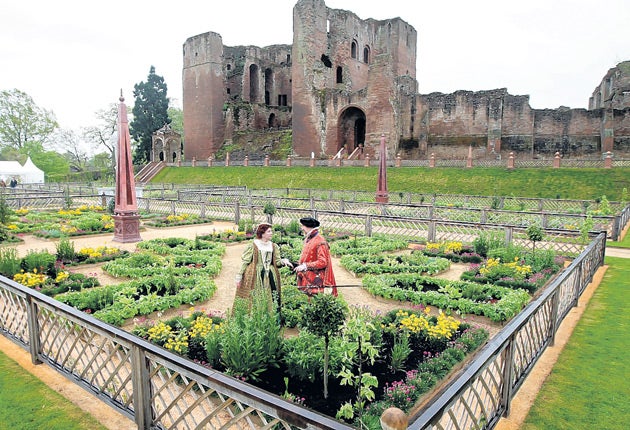Recreated, the Tudor garden where an ambitious earl wooed the Virgin Queen

Your support helps us to tell the story
From reproductive rights to climate change to Big Tech, The Independent is on the ground when the story is developing. Whether it's investigating the financials of Elon Musk's pro-Trump PAC or producing our latest documentary, 'The A Word', which shines a light on the American women fighting for reproductive rights, we know how important it is to parse out the facts from the messaging.
At such a critical moment in US history, we need reporters on the ground. Your donation allows us to keep sending journalists to speak to both sides of the story.
The Independent is trusted by Americans across the entire political spectrum. And unlike many other quality news outlets, we choose not to lock Americans out of our reporting and analysis with paywalls. We believe quality journalism should be available to everyone, paid for by those who can afford it.
Your support makes all the difference.It was a setting for one of the most famous love stories in English history. The great scented garden that Robert Dudley, the Earl of Leicester, created at Kenilworth Castle, his home in Warwickshire, especially to woo Elizabeth I has been re-created by English Heritage and opens to the public tomorrow.
Dudley was one of Tudor England's most powerful – and most glamorous – courtiers. He and Elizabeth had known each other since childhood. They had both been imprisoned in the Tower of London by Elizabeth's sister and predecessor, Queen Mary, who saw them as potential rivals for the throne. They had similar interests. What's more, they were deeply in love.
But Dudley's wife had died in an apparent accident at their home some years earlier and his political and religious enemies had accused him of deliberately killing her in order to try to marry Elizabeth. This potentially scandalous situation was among the considerations which had prevented the Queen from marrying him.
By 1575, Dudley decided to make one last plea to the Virgin Queen. He had the gardens of his home magnificently made over ready for her 19-day visit. He planned to stage a masquerade there in which an actor playing the "messenger of the gods" was to have bluntly told Elizabeth: "How necessarie were for worthy Queenes to wed, that know you wel whose life alwayes in learning hath beene led".
In the end it was cancelled, officially because of bad weather but more likely because the Queen found the planned garden masquerade politically inappropriate.
But Dudley did not give up. Instead he asked the man who had written the masquerade to run alongside the Queen's horse, warning her what would happen to Dudley if she spurned him. The Earl, she was warned, would turn into a holly bush called "Deep Desire!", adorned with "the restlesse prickes of his privie thoughts". Then, in even an more risqué comment, the warned the Queen that ladies too could become holly bushes. "Now some will say that the she-holy hath no prickes but thereof I intermeddle not," he quipped.
The one-acre walled garden is the first genuine Tudor garden ever to be recreated and the work has been made possible partly because of a vivid description of it written by Robert Langam, a member of Dudley's staff. In a letter thousands of words long, Langam describes the garden's size and layout, its paths and grass verges, its aviary, fountain, obelisks, statues and even the dimensions of the great terrace which overlooked it.
A team of researchers also conducted an exhaustive survey of images portraying other gardens of the Elizabethan Age to obtain crucial technical information not provided by the letter. Dozens of engravings by Dutch architect and artist Hans Vredeman de Vries and paintings by English artists were subjected to detailed study.
Some have speculated that the 19-day spectacle organised by Dudley was the inspiration for Shakespeare's A Midsummer Night's Dream. "However, the real significance of this extravagant event was political," said Dr Janet Dickinson, of Durham University, an authority on 16th-century English history.
"It was the point and place where Elizabeth finally said no to Dudley's offer of marriage. If she had said yes, subsequent English history would probably have been very different. As it was, she turned him down and her decision led to the coming of the Stuarts 28 years later."
In 1578 Dudley, spurned by Elizabeth, decided to marry Lettice Knollys, the daughter of the Queen's cousin, who looked strikingly similar to Elizabeth. The Queen called her "that she-wolf" and banished her from court. Dudley died a decade later and the Queen, stricken with grief, locked herself in her apartment until concerned courtiers ordered that the royal door be broken down. She kept Dudley's last letter to her in a casket by her bedside.
After Dudley's death, Kenilworth became crown property and by 1620 the garden had been grassed over. Its recreation has cost £2.1m but English Heritage is confident it will become one of the most popular historic attractions in England.
Join our commenting forum
Join thought-provoking conversations, follow other Independent readers and see their replies
0Comments